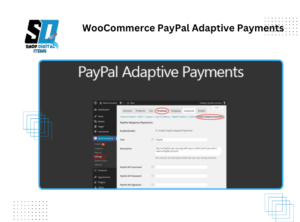Blog
WooCommerce PayPal Adaptive Payments: A Complete Guide

WooCommerce PayPal Adaptive Payments
In the world of eCommerce, ensuring smooth and secure transactions is crucial for business success. WooCommerce PayPal Adaptive Payments is an advanced payment solution that allows businesses to handle complex transactions, including split payments, chained payments, and parallel payments. This article provides an in-depth understanding of WooCommerce PayPal Adaptive Payments, its features, benefits, setup process, and use cases.
What is PayPal Adaptive Payments?
PayPal Adaptive Payments is a payment gateway service designed to facilitate multi-party transactions. This system allows merchants to send and receive payments to multiple recipients in a single transaction. It supports:
- Parallel Payments: Payments split between multiple recipients, where each gets their share simultaneously.
- Chained Payments: Payments routed through a primary receiver before being distributed to secondary recipients.
- Delayed Payments: Payments held for a specific period before being released to recipients.
These payment structures make PayPal Adaptive Payments ideal for multi-vendor marketplaces, service platforms, and affiliate programs.
Benefits of WooCommerce PayPal Adaptive Payments
1. Seamless Multi-Vendor Payments
For WooCommerce-based marketplaces, Adaptive Payments enables vendors to receive payments automatically without requiring manual intervention.
2. Flexibility in Payment Distribution
Business owners can configure payments to be made instantly, delayed, or in a structured manner based on commission models.
3. Improved Cash Flow Management
With delayed and chained payment options, businesses can ensure funds are appropriately managed before disbursing payments.
4. Enhanced Customer Experience
Shoppers experience smoother checkouts as payments are processed efficiently without confusion about multiple transactions.
5. Reduced Administrative Work
Automatic payment splitting eliminates the need for manual distribution, reducing errors and saving time.
How to Set Up WooCommerce PayPal Adaptive Payments
Step 1: Install WooCommerce and PayPal Adaptive Plugin
- Ensure you have an active WooCommerce installation on your WordPress website.
- Purchase and install the PayPal Adaptive Payments plugin for WooCommerce from a reputable source.
- Activate the plugin in your WordPress dashboard.
Step 2: Obtain PayPal API Credentials
- Log in to your PayPal Developer Account.
- Navigate to My Apps & Credentials.
- Create a new app and retrieve API credentials (Client ID, Secret Key, and API Signature).
Step 3: Configure WooCommerce PayPal Adaptive Payments
- In WordPress, go to WooCommerce > Settings > Payments.
- Enable PayPal Adaptive Payments and enter your API credentials.
- Set up payment modes: Parallel, Chained, or Delayed Payments.
- Define commission percentages for vendors if using a multi-vendor marketplace.
- Save settings and test transactions in PayPal Sandbox Mode.
Step 4: Enable Live Transactions
- Once testing is successful, switch from Sandbox Mode to Live Mode.
- Notify vendors about the payment structure.
- Start accepting payments using WooCommerce PayPal Adaptive Payments.
Use Cases for WooCommerce PayPal Adaptive Payments
1. Multi-Vendor Marketplaces
Platforms like Etsy, eBay, and Amazon benefit from Adaptive Payments by automatically splitting payments between vendors and marketplace owners.
2. Subscription-Based Services
Companies offering tiered subscription services can distribute payments to multiple service providers.
3. Crowdfunding Platforms
Fundraisers can allocate funds to multiple beneficiaries without manual processing.
4. Affiliate Commission Models
Businesses using affiliate marketing can instantly distribute commissions to affiliates.
5. Online Service Platforms
On-demand service platforms like Uber or Fiverr can distribute payments to service providers while keeping a commission.
Challenges and Considerations
1. PayPal Adaptive Payments API Discontinuation
PayPal has limited access to the Adaptive Payments API for new users. Existing accounts can still use it, but new WooCommerce users may need to explore alternatives like PayPal Payouts or Stripe Connect.
2. Compliance and Approval
Using PayPal Adaptive Payments requires approval from PayPal, which can take time. Ensure your business model aligns with PayPal’s policies.
3. Transaction Fees
Each payment split incurs PayPal fees, which vary based on transaction volume and recipient location. Businesses must account for these costs.
4. Technical Configuration
Setting up Adaptive Payments requires API integration, which may require developer assistance for proper configuration and troubleshooting.
Alternatives to PayPal Adaptive Payments
Given the discontinuation of new signups for PayPal Adaptive Payments, consider these alternatives:
- PayPal Payouts: Ideal for mass payments but lacks real-time splitting.
- Stripe Connect: A powerful solution for multi-vendor payments.
- WooCommerce Marketplace Plugins: Solutions like Dokan, WC Vendors, or MultiVendorX provide built-in payment splitting.
Conclusion
WooCommerce PayPal Adaptive Payments remains a powerful solution for businesses requiring seamless multi-party transactions. While its accessibility has become limited, existing users can leverage its features for efficient payment management. New users should explore alternative solutions like PayPal Payouts and Stripe Connect to achieve similar functionality.
By implementing the right payment strategy, businesses can improve cash flow, automate vendor payouts, and enhance customer trust, ultimately driving growth and scalability.
